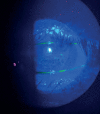Reactivation of Herpes Simplex Keratitis on a Corneal Graft Following SARS-CoV-2 mRNA Vaccination
- PMID: 35774041
- PMCID: PMC9233471
- DOI: 10.5455/medarh.2022.76.146-148
Reactivation of Herpes Simplex Keratitis on a Corneal Graft Following SARS-CoV-2 mRNA Vaccination
Abstract
Background: Ocular herpes simplex is usually caused by herpes simplex virus type 1 (HSV-1) and less commonly by the type 2 virus (HSV-2). Ocular manifestations of HSV include blepharitis, conjunctivitis, lacrimal system obstruction, corneal involvement, and uveitis. Corneal involvement is one of the causes of loss of vision and can be epithelial herpetic keratitis or stromal herpetic keratitis.
Objective: A significant population has a colonization of herpes viruses. Under certain circumstances, these viruses can reactivate with a significant ocular morbidity. Globally, COVID-19 vaccines are recommended; however, the vaccine safety data are limited.
Case report: Herein, we reported a case of herpetic keratitis reactivation that occurred 2 days after receiving SARS-CoV-2 mRNA vaccine. The patient is a 50-year-old man who underwent penetrating keratoplasty (PKP) in 2020 for corneal opacity caused by a previous herpes simplex keratitis in 2013. Herpetic keratitis was treated successfully with topical antiviral acyclovir along with topical moxifloxacin and artificial tears. After treatment, prophylactic oral acyclovir was started.
Conclusion: Both ophthalmologist and patients should be aware of this phenomenon. Long-term prophylactic antiviral treatment may be recommended for those patients.
Keywords: COVID-19; Penetrating keratoplasty; cornea; herpes simplex keratitis; vaccination.
© 2022 Rami A. Al-Dwairi1, Abdelwahab Aleshawi, Sharaf Adi, Laith Abu-Zreig.
Figures
Similar articles
-
Herpes Simplex Virus Keratitis Reactivation after SARS-CoV-2 BNT162b2 mRNA Vaccination: A Report of Two Cases.Ocul Immunol Inflamm. 2021 Aug 18;29(6):1238-1240. doi: 10.1080/09273948.2021.1986548. Epub 2021 Oct 12. Ocul Immunol Inflamm. 2021. PMID: 34637667
-
Reactivation of herpes simplex keratitis following vaccination for COVID-19.BMJ Case Rep. 2021 Sep 7;14(9):e245792. doi: 10.1136/bcr-2021-245792. BMJ Case Rep. 2021. PMID: 34493563 Free PMC article.
-
[Herpes simplex virus latency, reactivation, and a new antiviral therapy for herpetic keratitis].Nippon Ganka Gakkai Zasshi. 2008 Mar;112(3):247-64; discussion 265. Nippon Ganka Gakkai Zasshi. 2008. PMID: 18411713 Review. Japanese.
-
[Battle with herpes for 37 years].Nippon Ganka Gakkai Zasshi. 2015 Mar;119(3):145-66; discussion 167. Nippon Ganka Gakkai Zasshi. 2015. PMID: 25854108 Review. Japanese.
-
Efficacy of low-dose and long-term oral acyclovir therapy after penetrating keratoplasty for herpes simplex heratitis.Ocul Immunol Inflamm. 1999 Mar;7(1):51-60. doi: 10.1076/ocii.7.1.51.8113. Ocul Immunol Inflamm. 1999. PMID: 10410875 Clinical Trial.
Cited by
-
COVID-19 Vaccine-Associated Ocular Adverse Effects: An Overview.Vaccines (Basel). 2022 Nov 7;10(11):1879. doi: 10.3390/vaccines10111879. Vaccines (Basel). 2022. PMID: 36366386 Free PMC article. Review.
-
Corneal Adverse Events Associated with SARS-CoV-2/COVID-19 Vaccination: A Systematic Review.Vaccines (Basel). 2023 Jan 12;11(1):166. doi: 10.3390/vaccines11010166. Vaccines (Basel). 2023. PMID: 36680010 Free PMC article. Review.
-
COVID-19 vaccination and corneal allograft rejection- a review.Front Cell Infect Microbiol. 2023 Dec 15;13:1307655. doi: 10.3389/fcimb.2023.1307655. eCollection 2023. Front Cell Infect Microbiol. 2023. PMID: 38162575 Free PMC article. Review.
-
Possible viral agents to consider in the differential diagnosis of blepharoconjunctivitis.World J Virol. 2024 Dec 25;13(4):97867. doi: 10.5501/wjv.v13.i4.97867. World J Virol. 2024. PMID: 39722756 Free PMC article.
-
Herpes simplex keratitis: A brief clinical overview.World J Virol. 2024 Mar 25;13(1):89934. doi: 10.5501/wjv.v13.i1.89934. World J Virol. 2024. PMID: 38616855 Free PMC article. Review.
References
-
- Naumann G, Gass JD, Font RL. Histopathology of herpes zoster ophthalmicus. Am J Ophthalmol. 1968;65:533–541. - PubMed
-
- Biancardi AL, Moraes HV Jr. Anterior and intermediate uveitis following yellow fever vaccination with fractional dose: case reports. Ocul Immunol Inflamm. 2019;27(4):521–523. - PubMed
-
- Phylactou M, Li JO, Larkin DFP. Characteristics of endothelial corneal transplant rejection following immunisation with SARS-CoV-2 messenger RNA vaccine. Br J Ophthalmol. 2021 Jul;105(7):893–896. - PubMed
Publication types
MeSH terms
Substances
LinkOut - more resources
Full Text Sources
Medical
Miscellaneous


